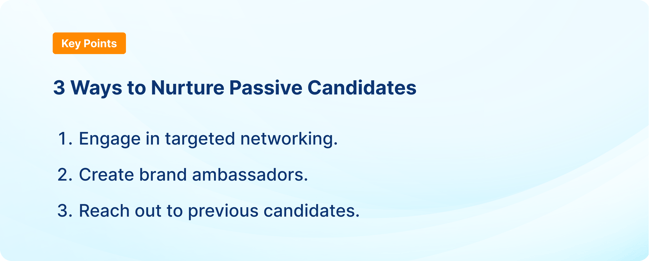

If you own or operate a trucking company, you already know how important it is to ensure your...

From delivering goods to transporting essential supplies, truck drivers are the backbone of the logistics sector. However, recruiting truck drivers and keeping them have been challenging in recent years.
Shortages have been persistent in recent years and exacerbated by countless supply chain disruptions, including the pandemic, shifting trade patterns, and the move toward reshoring and nearshoring. In 2023, the estimated shortage of truck drivers is 80,000, which could double by 2030.
To address this issue, trucking companies must focus on building a robust driver pipeline that ensures a steady supply of skilled professionals. Discover recruiting strategies for attracting potential drivers — and how a trusted background check partner can help.
Key Takeaways:
|
Disruptions in the trucking industry affect your ability to recruit and hire drivers. These disruptions include a shrinking talent pool, changes in consumer shopping patterns, and the latest technology advancements.
Truck driver shortages have plagued the industry for years, with companies regularly trying to close the gap between demand for truck drivers and the available supply of qualified professionals. This shortage has become a critical problem for the industry, affecting efficiency, productivity, and growth.
According to the American Trucking Association, “the shortage could surpass 160,000 in 2030. This forecast is based on driver demographic trends, including gender and age, as well as expected freight growth.”
Here are some of the factors affecting hiring in the trucking industry.
Trucking companies face a demographic problem: The driver workforce is aging, and many experienced truck drivers are reaching retirement age or no longer can handle the stringent physical health demands. Like many industries, trucking companies struggle to find candidates who are interested in and qualified for open roles.
The trucking industry faces additional challenges in attracting younger drivers. Many young people are choosing jobs in other industries with higher compensation, a better work-life balance, and less time away from home.
The demanding nature of truck driving and the lifestyle it entails can deter potential candidates. Many people have employment options that don’t require long hours, extended travel, or the physical demands of the role.
The driver shortage puts a strain on existing drivers, who often work longer hours to compensate for the lack of available personnel. This can lead to driver fatigue, decreased job satisfaction, and higher turnover.
The driver shortage also hampers the industry's ability to meet customer needs and maintain reliable delivery schedules. As demand for goods and services continues to rise, driver shortages can cause shipment delays, reduce customer satisfaction, and lead to lost business.
Trucking companies face numerous other disruptions that affect their ability to hire.
These include:
These disruptions highlight the need for innovative approaches, such as targeted recruitment strategies, improved training programs, and enhanced driver retention initiatives. Companies must adapt to these disruptions if they wish to maintain an effective workforce.

When top candidates are in high demand, you need a strategy that shows them why your company is the right choice for them. Consider implementing recruitment marketing — the process of promoting a company's job opportunities and employer brand to attract potential candidates.
Recruitment marketing targets your target audience, raises awareness of your job openings, and engages with them about job openings and your company's unique selling points. This approach can improve your reputation while attracting qualified drivers to apply.
Here are a few tips for getting your campaign started.
Review existing job descriptions for accuracy and clarity. These postings should contain key job requirements for the truck driver position, such as commercial driver's license (CDL) status, driving experience, endorsements, and any skills you need for specific routes or types of cargo.
Identify ideal characteristics for the truck driver candidates you want to attract. Consider factors such as experience, geographic location, and preferred driving routes. Create detailed personas that represent your ideal truck driver candidates. These personas should include demographic information, motivations, goals, and challenges. This exercise humanizes the target audience so you can develop tailored and inviting marketing content.
As part of your employer branding, showcase your value beyond pay and benefits. Demonstrate opportunities for career growth and advancement. Showcase chances for drivers to learn new skills, take on leadership roles, or switch to other areas of transportation. Your messaging should show how you invest in drivers' professional development.
Explain how the company helps drivers balance their health and the job. Highlight flexible schedules, home time policies, and other initiatives that promote work-life balance.
Understand what motivates, values, and inspires qualified drivers. For example, your messaging can illustrate how your drivers keep the supply chain moving. Highlight how their work moves goods, supports businesses, and keeps communities supplied.
Communicate the company's values and how you live them in daily practices. Living values include a commitment to safety, sustainability, employee well-being, and community involvement. Shared values help drivers feel purpose and connect with the company.
With your messaging in place, think about the content you need to create. For inbound recruiting efforts, you’ll need robust content on your careers site. When potential candidates land on your page, they can quickly learn more about what it’s like to work for you. External channels, such as public job boards or social media, can also be effective for sharing job postings and branded content.
Showcase testimonials or stories from current drivers who have found purpose and fulfillment in their work with the company. Highlight their experiences, achievements, and the positive impact they've made. This helps potential candidates imagine the possibilities of working with you.
Communicate your messaging through text, images, and videos to connect with candidates in different ways. Make sure to be diverse in your visual content so candidates, regardless of personal characteristics, can see themselves as a good fit in your company.
Determine the most effective channels to reach your target audience. This can include online job boards, social media, driver-specific recruitment websites, industry publications, and local driving schools. Tailor your messaging and content to suit each channel.
Make sure that your company's website and social media profiles are up to date and user-friendly. Optimize them for search engines to increase visibility. Provide easy-to-find information about job opportunities, application processes, and contact details.
Beyond organic content, use paid advertising on Facebook, Google, LinkedIn and other platforms to reach a wider audience. Whenever possible, target your paid spend on specific demographics, locations, and relevant interests.
Opening and maintaining lines of communication with potential job candidates helps you establish a relationship with them. Engage with candidates through personalized communication, combining information about your company with answers to their questions and concerns. Take the time to understand each candidate's background, skills, and career goals.
By asking relevant questions and actively listening to their responses, you can tailor communication to address the candidate's specific needs and interests. This personalized approach helps them feel valued and appreciated, increasing their likelihood of applying to you and accepting a role.
Provide support and guidance throughout the application and hiring process. Recruiters should promptly respond to candidate inquiries, provide updates on their application status, and offer help with paperwork or documentation. By being supportive and responsive, recruiters build trust and rapport with candidates.
Track the performance of your recruitment marketing campaign using analytics tools. Talent acquisition metrics to monitor include website traffic, application rates, and conversion rates.
Regularly review campaign performance and adjust based on feedback and data. Keep an eye on what competitors are doing and how recruiting best practices evolve so you can stay current with how to engage with truck driver candidates.

Don’t limit your recruitment efforts to people who are actively looking for work. The Great Resignation showed us that people are willing to leave their jobs for better opportunities.
Here are three ways to find and engage passive candidates.
Your recruiters have several ways to find passive candidates. Use social media platforms like LinkedIn, for instance, to search for potential candidates who have the skills and experience you need. Recruiters can contact these candidates directly, highlighting the company's unique selling points and the benefits of working for your organization.
Recruiters can attend industry events and networking functions to connect with passive job candidates. These events offer in-person conversations that can quickly build trust with potential candidates, even if they aren’t actively seeking new job opportunities.
Brand ambassadors are people who are proud to work for your company and willing to evangelize your brand to others. Empower these employees with the tools and resources they need to share their positive experiences and direct interested people to your career opportunities. By encouraging employees to share their on-the-job experiences on social media or by word of mouth, you can reach a wider audience of passive job candidates — and showcase your positive reputation.
A formal referral program can also help you build a pipeline of passive talent. Offer referral incentives or bonuses to your drivers if they successfully recommend hires from their networks. Passive candidates may be more likely to consider a job opportunity that’s recommended by someone they trust.
Sometimes, you have more qualified candidates than you can immediately hire. Don’t let that talent just walk away. Create a plan for staying in touch with high-potential candidates, such as through your email list or other touch points. This effort starts on your application form, where you can ask candidates to opt in to receive content from you.
From there, develop a nurture email campaign that addresses issues relevant to these qualified job seekers. You can educate and engage with these truck drivers while sharing job notifications as they arise.

Curating a great candidate experience matters to your trucking company. When candidates have a positive experience of the recruitment process, they're more likely to view the company favorably — and consider accepting a job offer.
Here are a few best practices for improving your candidate experience.
While DOT job application processes are inherently long and specific by law, you can work with your background screener to help keep the driver engaged in the process. Use user-friendly online application forms that are easy to navigate and optimized for mobile devices.
Have a conversation with DOT candidates to see if they are a good fit with your company before engaging them in the application process. If you need applicants who already hold their CDL, for instance, ask them early. You can set your applicant tracking system to automatically reject candidates without a CDL, for example, so they don’t waste their time (and yours) completing the application.
Many employers fail to communicate regularly with job applicants. In fact, 34% of candidates wait one to two months (or longer) after applying to learn about next steps, Talent Board reports. Brands can easily differentiate themselves simply by supplying timely, relevant updates to candidates.
Respond promptly to candidate inquiries and keep them informed throughout the hiring process. Provide status updates, including expected timelines and next steps.
Provide timely feedback to candidates after interviews or assessments, regardless of the outcome. Offer constructive feedback to help candidates understand areas for improvement and show appreciation for their time and effort.
Treat candidates as individuals by personalizing your communication with them. Address them by name, acknowledge their qualifications or experiences, and tailor your interactions to their needs.
Develop workflows, for instance, that customize how you deliver updates to candidates based on their preferences. Many people prefer updates via text-based push notifications, for example, rather than more formal channels like a phone call or an email.
Streamline the interview process to minimize delays and keep candidates engaged. Conduct efficient, short, and well-structured interviews, giving the driver realistic expectations about their role. Include not only the recruiter, but also the fleet manager in the hiring process.
In addition to the traditional interview, use assessments to evaluate a candidate’s skills. These can provide more objective, data-driven insights into a candidate’s fit for the job. Assessments also help candidates view the hiring process as fair.
Make sure that the background screening process respects privacy laws and other regulations. Clearly communicate how candidates’ personal information will be handled and stored securely.
Streamline employment verifications with technology. Provide candidates with easy-to-use online portals or mobile applications where they can securely submit required information and track progress.
Background screening plays a crucial role in the truck driver recruitment process by helping to ensure the safety and reliability of potential candidates. Thorough background checks help employers verify candidate-provided information, assess driving records, and identify relevant criminal history that might disqualify candidates. Background checks mitigate the risk of hiring drivers who pose a threat to public safety or have a history of irresponsible on-the-job behavior.
A trusted background check partner can help in this process, providing the expertise and resources needed to conduct comprehensive, accurate, and efficient screenings. They can verify driving records, check for criminal convictions, confirm employment history, and validate educational qualifications.
Reliable partners follow legal requirements, ensure compliance with industry standards, and protect the employer from potential liabilities. They can also provide guidance on best practices and help interpret the results of background checks, helping employers make informed hiring decisions. Ultimately, a trusted background check partner streamlines the hiring process, improves hire quality, and enhances the company’s safety and reputation.
Ready to improve your hiring process? Schedule a call with one of our background screening experts.
Author: Michael Kapuschinsky
Bio: Product Manager with more than a decade of experience in the transportation industry.
Let's Connect on LinkedIn
If you own or operate a trucking company, you already know how important it is to ensure your...

Recently, Carlo Solórzano, Senior Director of Sales & Business Development at Driver iQ, joined the...

Safety is a top priority in the transportation and trucking industry. A key tool for risk...